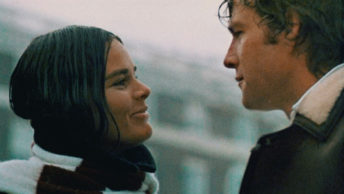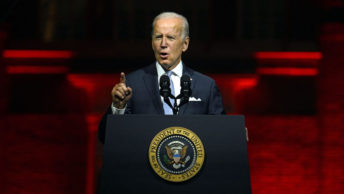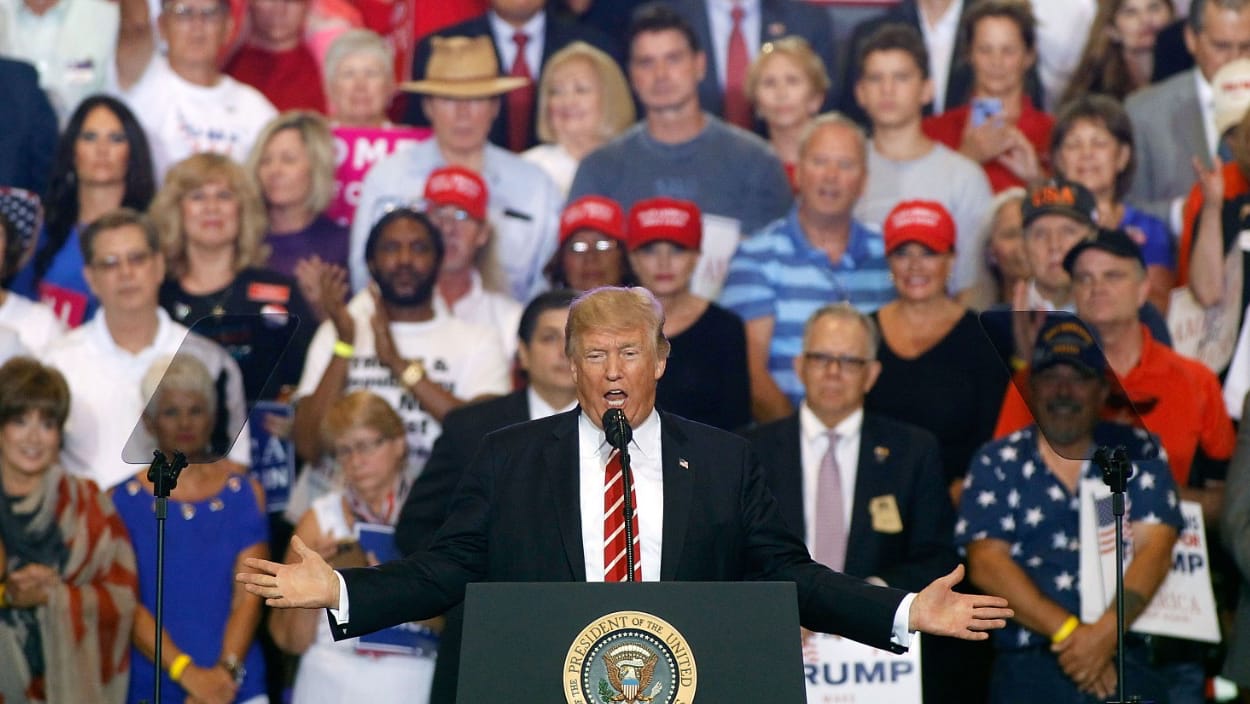Hollywood actress Meryl Streep’s tirade against Donald Trump and Republicans in general at the January 2017 Golden Globe awards ceremony drew the ire of conservatives and got her the publicity she wanted as a progressive activist. This speech will not go down in the history books. It conveyed neither the eloquence nor the substance of Lincoln’s “House Divided” speech or Martin Luther King’s “I Have a Dream” speech.
Conservatives should not dismiss Streep too quickly, though. She represents the voice of Hollywood, which remains influential in popular culture and in its ability to attract media attention. Hollywood progressives and pop celebrities may not have been able to elect Hillary Clinton, who lacked the magnetism of Obama. Still, the corrosive influence of Hollywood, the mainstream media, universities and popular culture remains steady, like water seeping into the foundations of a building and forming a quicksand that ultimately causes the building to collapse.
Pop culture is a cultural quicksand that threatens what Republicans have built politically. While Republicans have gained control of the White House, Congress and 33 state legislatures, the progressive cultural front continues to make inroads. The Republican edifice is vulnerable to being undermined by left-wing propaganda intent on winning the youth, women and minorities in the future.
Warning to Republicans
Pundits have pored over the 2016 election results in great detail. The one conclusion agreed to by everyone is that Hillary Clinton could not replicate the success of Obama’s coalition of the very rich and the very poor; white women and ethnic minority voters; and inner-city and suburban voters. Whether Obama’s coalition, based largely on identity politics, can be expanded and rebranded to ignite a Democratic Party resurgence is arguable. Republicans should not, however, underestimate the Democratic Party’s strength.
Conservatives should remember that after the 2008 presidential election, many concluded that the conservative era was over. New York Times Book Review editor Sam Tannenhaus proclaimed in his Death of Conservatism (2009) that America had entered into a new progressive epoch. The midterm elections of 2010 and 2014, and the presidential election of 2016, proved Tannenhaus’s prediction wrong. Conservatism was not dead; it was only constrained by the Electoral College, which seemed to favor Democrats. Donald Trump blasted a path around this roadblock by driving straight through Ohio, Indiana, Wisconsin and Pennsylvania.
Tannenhaus’s argument concerning the demise of conservatism was founded on two premises. First, ideological conservatism was irrelevant in a globalized economy in which many citizens depended on government entitlements to subsist. His second premise, based on demographic changes in America, seemed more plausible. The proportion of ethnic minorities, especially Hispanics, was growing, while the white population was declining. Older white voters, while turning out to vote in larger numbers than young voters, were a declining proportion of the electorate. More women were working; two-parent homes were in decline; and young voters were more secular, progressive on social issues, and just did not relate to the old fogies, Bible-thumpers and country-club set in the Republican Party.
In 2009, Tannenhaus appeared to make a lot of sense. He was not alone in his prognosis. While conservatives took issue with him in public forums, many wondered if maybe he and others were right that the Republican Party was headed toward a demographic cliff. Republican strategists and commentators fiercely debated whether the declining Republican Party could mobilize enough Hispanic voters to save it, or could attract more blue-collar workers. A few, such as Donald Critchlow, Future Right: The Forging of a New Republican Majority (2016), maintained that this either/or debate was moot because Republicans had an opportunity to appeal to every demographic group that Democrats were counting on to be the dominant party of the future.
Trump’s campaign showed that white voters—non-college-educated and college-educated, men and women—joined with enough Hispanic voters (29 percent), can win a presidential election.
Before conservatives get complacent about the failure of Tannenhaus’s thesis, a little caution is in order. Demographics are not destiny, but culture is. Progressives and Democrats still have something going for them when it comes to demographics and even more going for them when it comes to controlling culture.
Republicans in an Unstable Time
Republican future success depends on the new Trump administration to grow the economy, create jobs and avoid foreign policy catastrophe. The Obama administration entered a messy world, both domestically and internationally, and left it even messier for the incoming Trump administration. Republicans won the White House with an unstable coalition and Trump lost the national popular vote. A shift of a little more than 100,000 votes in the Rust Belt would have given Hillary Clinton the White House. She won the popular vote by carrying states such as New York and California decisively.
Democrats can continue to count on this coastal vote well into the future. The lack of viable, if any, Republicans on the down-ticket in states such as California means that many Republicans do not bother to vote at all. They know that Democrats are going to win the state’s electoral votes and most statewide and local elections. This same phenomenon is found in many other blue states.
Geographically, Republicans have a clear advantage, as most states today can be painted Republican Red. In 2016, Republicans won 51 percent of the popular vote for Congress, which meant control of 55 percent of the seats in Congress. But this is a fragile base, which appears stronger than it really is. A small shift in voters to the Democrats can reverse Republican gains. Such a shift occurred in the 2006 midterms, in which House Democrats mobilized against Bush and an unpopular war in Iraq to win back the House. This momentum was carried into the 2008 election, when Obama won the White House and Democrats maintained control in Congress. The result was Obamacare.
Trump voters and traditional Republican leaders are not necessarily on the same page. Republicans know they need to show that they are a party that can govern and enact reform legislation. Here is the rub, however. Trump and congressional Republicans led by Paul Ryan in the House and Mitch McConnell in the Senate may not agree with Trump on the legislative specifics of immigration, entitlement reform, trade policy or fiscal policy. Trump and Republican congressional leaders may reach an accord on building a wall, or at least part of the wall, on the southern border. When it comes to serious reform as what to do with the 11 million or more undocumented people who have entered the United States illegally, some of them a generation ago, there might be a serious divide between the White House and Congress and within the party itself.
Similar tensions are likely to arise over entitlement reform. Republicans agree that Obamacare needs to be repealed and replaced. What should replace it is more problematic. And Obamacare is only one entitlement program that needs addressing. There remain Social Security and Medicare. Trump ran on a promise of not touching Social Security. This is a promise most likely to be forgotten. Of the entitlement programs that need fixing, Social Security is low-hanging fruit, but other entitlement reform will be difficult. Medicare/Medicaid reform presents a more toxic problem than Hercules confronted in cleaning out the Augean stables. For one thing, there were no interest groups trying to protect the stables.
Spending Priorities and National Debt
The national debt is another pressure point for the Republicans. Fiscal hawks in Congress are wary of Trump’s call for a massive infrastructure program. Everyone knows that the nation needs to address its infrastructure problems. Our bridges, roads, airports, sewer plants and power stations are deteriorating. Infrastructure construction means more jobs. Better infrastructure enhances trade and helps grow the economy. Yet spending trillions of federal dollars when the nation has been left with a $20 trillion-plus deficit is going to face opposition. Be assured many Democrats in Congress will now declare themselves fiscal conservatives concerned with the national debt. (Remember Obama asserting when he ran for president in 2008 that allowing the national debt to soar should be considered an act of treason?) The Republican Party has some serious fiscal hawks who will be wary of too much infrastructure spending.
Rifts could also occur over military spending, although this is less likely because most Republicans agree that our national and strategic defenses need strengthening. A strong military rests ultimately on being ahead of one’s enemies in technology. Technology costs money.
The more serious challenge conservatives and Republicans face, though, is the left’s hegemony in popular culture, mainstream media and educational institutions, all of which exert outsize influence on young and ethnic voters. This is cultural quicksand for the nation.
Vileness in Pop Culture
Progressives are intent on changing the cultural mores of our youth. This is not a new phenomenon by any means, but it has intensified and the messages being sent to our youth are worse given the secularized nature of American culture.
Examples of the insidious nature of popular culture abound. Recently feminist actress and outspoken liberal Lena Dunham began a podcast relating how she was embarrassed that she had never had an abortion. Her embarrassment came, she told her listeners, when she visited a Planned Parenthood clinic and approached a young woman about her experience having an abortion. Dunham realized that she was about to interview a woman stigmatized by having an abortion, an experience that Dunham had not shared. This unshared experience made Dunham want to have an abortion, so she could share in the stigmatization of her gender. She declared, “Now I can say that I still haven’t had an abortion, but I wish I had.” This would make her a better advocate for a woman’s right to choose abortion.
Dunham’s sentiment can be dismissed as another privileged white woman trying to relate to an alleged victim of oppressive society. Yet she is only one voice among many pushing a left-wing cultural agenda. The Salon website recently published “TV’s Best Abortion Moments of 2016.” There proved to be many. Salon cited the romantic sitcom You’re the Worst, in which the show’s major character, Lindsay, casually tells her friend while eating a pie, “I’m eating for two for the last time. Let’s go get this abobo!” Notice how the script writers changed the word abortion into a silly-sounding slang word, “abobo,” as if having an abortion were analogous to trekking to a local supermarket, rapping with friends or going bar-hopping.
Salon noted that in the animated comedy BoJack Horseman the characters sing “Get dat fetus. Kill dat fetus.” The lyrics included a line, “I’m a baby killer/Baby killing makes me horny,” before turning to the stanza, “And sometimes I do have doubts and it’s hard to sleep/I think about my child’s heartbeat and oh it makes me weep/I hope and pray to God my little fetus has a soul/Because I want it to feel the pain when I reject it from my hold.”
A pro-abortion message is not the only message being pressed by progressives. MTV released in January a video entitled “Dear White Guys” in which a diverse group of millennials lecture white men on their many sins. One woman implores her viewers to realize that “America was never great for anyone who wasn’t a white guy.” Another “celebrity” on the video exhorts white males to “learn what mansplaining is, then stop it.” (“Mansplaining” is a term coined by feminists to denigrate a supposed tendency of white males to explain things to women in a condescending way.)
Gun Control Propaganda on Screen
Progressive views on abortion, racism, sexism, global warming, and gun control permeate television programming and movies. In December, Hollywood released the film, Miss Sloane, which brought to the screen an unabashedly pro-gun control message. Hollywood must have been worried that the pro-Hillary television drama Madam Secretary, testimonials by movie celebrities and executives, and its many fundraisers for their candidate might not be enough to win the White House for her, so they produced this movie. The plot of Miss Sloane concerns an oily female lobbyist who in an act of moral awakening decides to have her boutique lobbying firm support a Brady-like gun control bill. She stands up to the National Rifle Association and the gun industry.
This film is about well-funded lobbyists allowing terrorists and nutcases to buy guns at gun shows and carry concealed weapons with the intent of killing innocent Americans. It ignores the big money on the other side of the gun control debate, such as $50 million spent by former New York mayor Michael Bloomberg to push state gun control laws. Miss Sloane had the 75th worst opening weekend of any movie since 1982, but it was part of a steady drumbeat of progressive messages. Worth noting is that the activist group Everytown for Gun Safety works with television and movie studies to insert a gun-control message into scripts.
Pop culture is more than just television and the movies. The youth are inundated with progressive messages about racism, sexism and hatred of police by celebrities in the music industry. A destructive stream of vulgar messages pours out of rappers such as Lil Wayne, Dizzee Rascal and Drake. These are the celebrities of today’s youth, white and black, who hear through a heavy beat that drugs are cool, police are the enemy, women are to be degraded, corporations are bad, and gangster culture and violence are better than religion, middle-class values or working hard to get ahead.
Brainwashing young people with messages trivializing abortion, demonizing police officers, glorifying promiscuity and drugs, and bashing capitalism is not only bad for public morality and social order. It also leads to more votes for the left-wing agenda.
The Cultural Front
The cultural front is not a conspiracy of a few Soros-backed progressives, but a tacit shared opinion that the average, hard-working, church-going American lives in a backward, unenlightened culture. For progressives, two-parent families, traditional values and Judeo-Christian mores represent white privilege, sexism, homophobia and xenophobia. There are obvious contradictions in the progressive message. Hollywood promotes violence and sexism in its movies in which anti-heroes carry guns, kill at random and blow up cars. Women are still portrayed as sex objects, even though they might be martial arts experts and deadly killers themselves.
The cultural front pushes forward through popular culture, beginning with television, the movies and music. Its message is reinforced by a biased mainstream media and in the education establishment. Progressives carry their message to the social media through websites and blogs. The message is a watered-down cultural Marxism sentiment that traditional values, mores and established institutions are oppressive and need to be overthrown in the name of social justice and progress; traditional religious organizations are run by charlatans and hypocrites; and all politicians and public servants are controlled by corporations and the military.
The great irony of the progressive message is that it is not progressive at all. Social anarchy is not new or progressive. Civilization always teeters on the edge of social chaos, barbarism and world disorder. The actual course of progress and social order in the West has been through the rule of law, freedom to prosper and innovate, and a conception of the dignity of the individual regardless of race, gender or social status. This path to true progress is the core of traditional Judeo-Christian culture.








